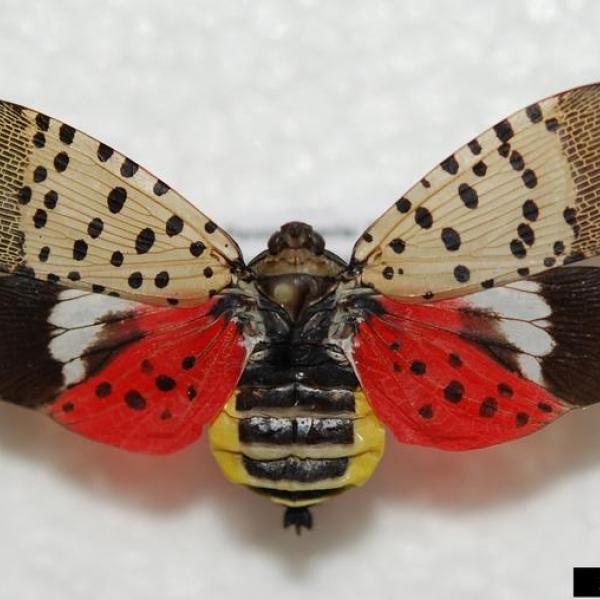
In a state where agriculture and forestry are important industries, the spotted lanternfly (Lycorma delicatula) is not a welcomed guest. First discovered in Berks County, Pennsylvania in 2014, the colorful invasive from China poses a threat to timber, viticulture, fruit and nursery businesses. By the end of 2017, nearly 3,000 square miles of the state have been affected.
Soon after arriving in Korea in 2004, this insect became a significant economic pest. In January 2018 the lanternfly was found in Frederick County, Virginia, an area that includes vineyards and other agriculture. It is not known to be in Vermont.
The spotted lanternfly adult is about one inch long and half an inch wide. The abdomen is yellow with black bars running across. It is the color and pattern of the wings that give it its name. The forewing is gray and speckled black at the base and black with gray cross veins near the tips. The hind wings feature a bright red base, a white stripe in the middle and a black tip. Young nymphs are black with white spots. The fourth nymphal instar turns red and black before maturing.
The spotted lanternfly is a sap-feeding planthopper. Nymphs and adults feed on sap from stems and leaves. Both life stages have been found on apples, plums, cherries, peaches, nectarines, apricots, almonds, grapes as well as forest trees like maples, oak, pine, walnut, poplar willow and sycamore. When it is present, adults prefer tree of heaven (Ailanthus altissima), which is also an invasive species. Damage is done in two ways. Removing sap reduces photosynthesis, weakening the plant. Host plants are also damaged indirectly as the adults excrete honeydew which allows the growth of sooty mold fungus on the leaves, stems, and fruit. This growth further reduces photosynthesis and attracts ants, flies, wasps, and bees.
In the fall adults congregate in large groups on tree trunks, especially of tree of heaven. Females begin to lay eggs in late September on trunks, branches, stones, and many other smooth surfaces. The egg masses typically contain 30-50 eggs and are usually about an inch long. The egg masses are gray and covered with a material that first appears waxy, like wet mud and then dries and cracks. The insect overwinters in the egg mass. Nymphs hatch out in the spring and begin to mature in early summer.
The primary host, tree of heaven, is often found growing along roads and power line right of ways, which may provide a corridor for infestations to spread. Nymphs cannot fly but have been found on a wide variety of hosts suggesting that they are able to spread to some extent. Adults are weak fliers, more often jumping away from danger. New infestations are often established by humans moving mated females or material with egg masses attached.
Management of spotted lanternfly may involve reducing host species by cutting tree of heaven or creating trap trees by treating tree of heaven with a systemic insecticide. Nymph populations can be reduced with sticky bands on trees. Scraping egg masses from surfaces may help keep populations down.
Early detection is important for managing any invasive. Suspected finds should be reported to local authorities. In Vermont, go to vtinvasives.org.
Article credit: Jim Esden, Vermont Department of Forests, Parks and Recreation
Photo credit: Lawrence Barringer, Pennsylvania Department of Agriculture, Bugwood.org